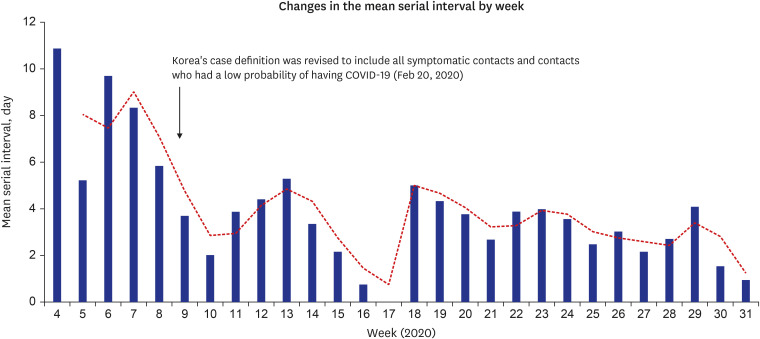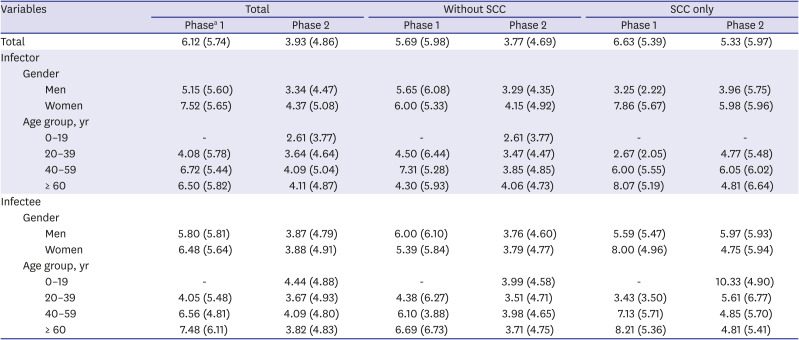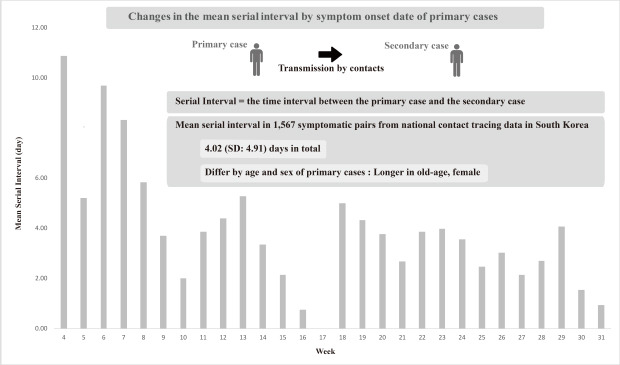This article has been
cited by other articles in ScienceCentral.
Abstract
Although coronavirus disease 2019 (COVID-19) is an ongoing pandemic, the mean serial interval was measured differently across nations. Through the Korean national COVID-19 contact tracing system, we were able to investigate personal contacts in all symptomatic cases in Korea from January 20 to August 3, 2020. The mean serial interval was calculated by the duration between the symptom onset of the infector and infectee, and became shorter after the case definition changed to include not-imported cases in Korea on February 20, 2020. The mean serial interval before and after this fifth case definition was 6.12 and 3.93 days based on the infectors' symptom onset date, respectively, and 4.02 days in total with the median of 3 days. Older age and women lead to longer serial intervals.
Go to :

Graphical Abstract
Go to :

Keywords: Coronavirus, COVID-19, Contact Tracing, Epidemiology, Disease Transmission, Serial Interval
The novel coronavirus disease 2019 (COVID-19), which originated in Wuhan, China, became a global pandemic very quickly.
1 The unexpected spread of COVID-19 was due to the pre-symptomatic phase, which led to increased transmission rates and shorter serial intervals than other viruses.
2 Therefore, many studies have attempted to estimate the intervals of transmission
3456789 and the results ranged from 3.7 to 7.5 days. However, the estimations in previous studies include some limitations. First of all, most studies used confirmed date instead of symptom onset date. Calculating only serial intervals by confirmed date instead of the date of symptom onset cannot reflect the activity of viruses concisely since the confirm date could be strongly associated with the capacity of test or epidemiologic investigations. Second, studies mostly did not include causal contacts as considerations, which is crucial to reveal actual infection chains of the disease. Also, because not every investigation provides the infector as the index case, researchers should arrange the relationship of the infector and the infectee through their symptom onset and contact date, but this procedure is neglected. The purpose of this study was to estimate the mean serial interval for COVID-19 using data from the Korean COVID-19 contact tracing system.
10
Baseline demographic characteristics and epidemiological features of matched pairs of COVID-19 patients were derived from the COVID-19 reporting and contact tracing system run by the Korea Centers for Disease Control and Prevention (KCDC). We investigated all confirmed cases in Korea from January 20 to August 3, 2020 (COVID-19 National Emergency Response Center, Korea, 2020). Confirmed cases were defined by a real-time reverse transcriptase-polymerase chain reaction (RT-PCR) test. Symptoms include respiratory or systemic ones such as fever, myalgia, headache, cough, sore throat, and shortness of breath.
The serial interval is defined as the time interval between the onset dates of symptom(s) in the infector and the infectee. The baseline characteristics and the mean serial intervals were estimated. Mean serial intervals by symptom onset in infectors were also reported. The estimated mean values were reported as a total and then reported with only the specific church cluster in Daegu and without it, since the contact relationships may be inaccurate in this region because of the massive transmission. The different serial intervals of the various groups were evaluated statistically with t-tests or analysis of variance tests. All data management or analyses were performed in R-3.5.3 (R Foundation for Statistical Computing, Vienna, Austria).
Among the initial matched pairs, infectees with duplicate infectors or asymptomatic infectors or infectees with unconfirmed serial intervals were excluded (232 pairs) for the analysis. As a result, 1,567 symptomatic pairs were used in the calculation, including 969 infectors and 1,567 infectees. The mean ages of the infectors and the infectees were 49.43 (standard deviation [SD], 17.98) and 47.37 (SD, 20.04) years, respectively. The proportion of women to men favoured women in both groups, at 55.11% and 52.71%.
The mean serial interval of the total population was 4.02 (SD, 4.91) days. The median of the serial interval was 3 days. Of total, 12.7% (199 pairs) of serial intervals were negative.
Fig. 1 shows the trend of serial intervals based on the onset date of the infectors. With time, a later onset of symptoms seems to have shorter serial intervals. The mean serial interval became stable after February 20, when Korea's case definition was revised. Since before February 20, only imported cases and their clear contactors were suggested to have RT PCR test, community level transmission could have been lost. After February 20, the case definition started to cover all symptomatic contactors or patients for whom the probability of having COVID-19 is doubted by a doctor. The mean serial interval of the first phase (Phase 1) was 6.12 (SD, 5.74) days, and that of the next phase (Phase 2) was 3.93 (SD, 4.86) days.
 | Fig. 1
The trend of mean serial intervals by the onset date of infectors.
COVID-19 = coronavirus disease 2019.

|
The mean serial intervals and standard deviations were estimated in two phases by groups (
Table 1). In total, the mean serial intervals for men were significantly shorter than those for women, 3.34 (SD, 4.47) and 4.37 (SD, 5.08) days, respectively, in Phase 2. Infectors' age groups showed a significant difference in the mean serial interval in Phase 2, which showed increasing values with higher age groups.
Table 1
Mean serial interval of population by groups

|
Variables |
Total |
Without SCC |
SCC only |
|
Phasea 1 |
Phase 2 |
Phase 1 |
Phase 2 |
Phase 1 |
Phase 2 |
|
Total |
6.12 (5.74) |
3.93 (4.86) |
5.69 (5.98) |
3.77 (4.69) |
6.63 (5.39) |
5.33 (5.97) |
|
Infector |
|
|
|
|
|
|
|
Gender |
|
|
|
|
|
|
|
|
Men |
5.15 (5.60) |
3.34 (4.47) |
5.65 (6.08) |
3.29 (4.35) |
3.25 (2.22) |
3.96 (5.75) |
|
|
Women |
7.52 (5.65) |
4.37 (5.08) |
6.00 (5.33) |
4.15 (4.92) |
7.86 (5.67) |
5.98 (5.96) |
|
Age group, yr |
|
|
|
|
|
|
|
|
0–19 |
- |
2.61 (3.77) |
- |
2.61 (3.77) |
- |
- |
|
|
20–39 |
4.08 (5.78) |
3.64 (4.64) |
4.50 (6.44) |
3.47 (4.47) |
2.67 (2.05) |
4.77 (5.48) |
|
|
40–59 |
6.72 (5.44) |
4.09 (5.04) |
7.31 (5.28) |
3.85 (4.85) |
6.00 (5.55) |
6.05 (6.02) |
|
|
≥ 60 |
6.50 (5.82) |
4.11 (4.87) |
4.30 (5.93) |
4.06 (4.73) |
8.07 (5.19) |
4.81 (6.64) |
|
Infectee |
|
|
|
|
|
|
|
Gender |
|
|
|
|
|
|
|
|
Men |
5.80 (5.81) |
3.87 (4.79) |
6.00 (6.10) |
3.76 (4.60) |
5.59 (5.47) |
5.97 (5.93) |
|
|
Women |
6.48 (5.64) |
3.88 (4.91) |
5.39 (5.84) |
3.79 (4.77) |
8.00 (4.96) |
4.75 (5.94) |
|
Age group, yr |
|
|
|
|
|
|
|
|
0–19 |
- |
4.44 (4.88) |
- |
3.99 (4.58) |
- |
10.33 (4.90) |
|
|
20–39 |
4.05 (5.48) |
3.67 (4.93) |
4.38 (6.27) |
3.51 (4.71) |
3.43 (3.50) |
5.61 (6.77) |
|
|
40–59 |
6.56 (4.81) |
4.09 (4.80) |
6.10 (3.88) |
3.98 (4.65) |
7.13 (5.71) |
4.85 (5.70) |
|
|
≥ 60 |
7.48 (6.11) |
3.82 (4.83) |
6.69 (6.73) |
3.71 (4.75) |
8.21 (5.36) |
4.81 (5.41) |

The present study explored the mean serial interval of COVID-19, including all symptomatic pairs after the index import case on the national level. Along with this wide coverage, we reviewed contact dates and causes of disease in pairs, attempted to find out the sequential relationship between pairs, and finally used the selected infector-infectee pairs who showed clear relationships. Although 12.7% of serial intervals showed negative values, this figure could be reasonable considering the possibility of pre-symptomatic transmission.
3 The mean serial intervals were reported rather than median values for comparability with other studies or considering pre-symptomatic transmissions.
It is not possible to directly correlate the causal relationship between the revision of the case definition on February 20 and the decrease of serial intervals. The number of newly confirmed cases, the capacity of epidemiological investigations, and the effects of other location tracking systems might have a compound effect on the reduction of the mean serial interval. However, it is clear that variation of the mean serial interval was minimized after the revision of case definition, indicating the possibility of the revision as being one of the causes.
Longer serial intervals in women or old age group should be interpreted with concern. Demographical factors may have affected the serial interval by its nature or sociologic difference in behaviors or gathering patterns. Until now, there are lack of studies revealing the difference between sex or age in transmission pattern. Also, because the data were derived from the ongoing pandemic situation, it has potential to be changed, further follow-up studies are needed. Because determining the serial interval of COVID-19 is critical for controlling the pandemic, more contact relationships should be investigated and analyzed.
Ethics statement
Because the data were collected to facilitate rapid response for disease control by the government, informed consent was waived under the approval of the Korea University Institutional Review Board (KUIRB-2020-0193-01).
Go to :

ACKNOWLEDGMENTS
The authors thank the COVID-19 National Emergency Response Center in Korea for providing epidemiologic investigation data for the analysis.
Go to :

Notes
Go to :

References
1. Rothan HA, Byrareddy SN. The epidemiology and pathogenesis of coronavirus disease (COVID-19) outbreak. J Autoimmun. 2020; 109:102433. PMID:
32113704.

2. Lai CC, Shih TP, Ko WC, Tang HJ, Hsueh PR. Severe acute respiratory syndrome coronavirus 2 (SARS-CoV-2) and coronavirus disease-2019 (COVID-19): the epidemic and the challenges. Int J Antimicrob Agents. 2020; 55(3):105924. PMID:
32081636.

3. Du Z, Xu X, Wu Y, Wang L, Cowling BJ, Meyers LA. Serial interval of COVID-19 among publicly reported confirmed cases. Emerg Infect Dis. 2020; 26(6):1341–1343. PMID:
32191173.

4. Li Q, Guan X, Wu P, Wang X, Zhou L, Tong Y, et al. Early transmission dynamics in Wuhan, China, of novel coronavirus-infected pneumonia. N Engl J Med. 2020; 382(13):1199–1207. PMID:
31995857.
5. Nishiura H, Linton NM, Akhmetzhanov AR. Serial interval of novel coronavirus (COVID-19) infections. Int J Infect Dis. 2020; 93:284–286. PMID:
32145466.

6. Shim E, Tariq A, Choi W, Lee Y, Chowell G. Transmission potential and severity of COVID-19 in South Korea. Int J Infect Dis. 2020; 93:339–344. PMID:
32198088.

7. Zhao S, Cao P, Gao D, Zhuang Z, Cai Y, Ran J, et al. Serial interval in determining the estimation of reproduction number of the novel coronavirus disease (COVID-19) during the early outbreak. J Travel Med. 2020; 27(3):taaa033. PMID:
32163140.

8. Zhang S, Diao M, Yu W, Pei L, Lin Z, Chen D. Estimation of the reproductive number of novel coronavirus (COVID-19) and the probable outbreak size on the Diamond Princess cruise ship: a data-driven analysis. Int J Infect Dis. 2020; 93:201–204. PMID:
32097725.

9. Du Z, Xu X, Wu Y, Wang L, Cowling BJ, Meyers LA. Serial interval of COVID-19 among publicly reported confirmed cases. Emerg Infect Dis. 2020; 26(6):1341–1343. PMID:
32191173.

10. COVID-19 National Emergency Response Center. Epidemiology & Case Management Team. Korea Centers for Disease Control & Prevention. Contact transmission of COVID-19 in South Korea: novel investigation techniques for tracing contacts. Osong Public Health Res Perspect. 2020; 11(1):60–63. PMID:
32149043.
Go to :



